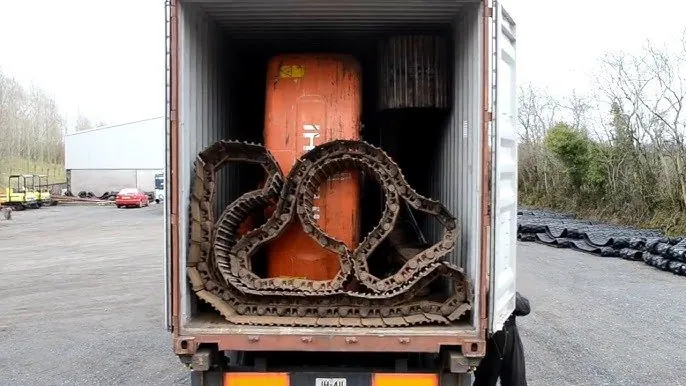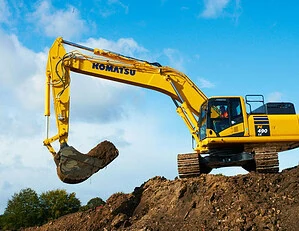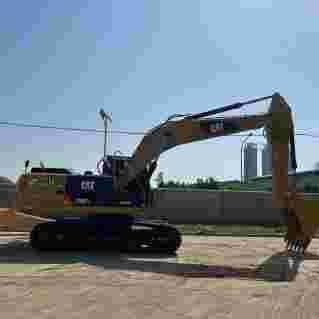When containers are involved there are many pieces of excavator transportation equipment that work closely together to get this load from one location to another. When everything is not done correctly, this machine has thousands or tens of thousands of dollars worth of damage to it or a transport delay on the road which could have so easily been avoided with a better understanding of the loading techniques.
To ensure the safe transportation of an excavator, selecting the right container and loading it correctly is crucial. By considering the excavator’s weight, dimensions, and required transportation documents, potential issues during transport can be minimized. Additionally, following professional loading steps and best practices, while leveraging modern technology, ensures an efficient and safe transportation process. This article provides detailed loading guidelines and useful advice to help you successfully transport your excavator.
Next, we’ll dive into the key factors to consider before loading une excavatrice, helping you better plan the transportation process.

Table des matières
BasculerWhat to Consider Before Loading an Excavator for Transportation
Proper planning and preparation are a must for loading an excavatrice in a container. Here are some of the important factors that will affect how the loading process unfolds.
Weight and Size Considerations for Excavator Shipping
The weight and size of the excavator are the biggest factors that affect what type of container you will use and how you will load it. If you get this step wrong you are in a world of hurt. You can buy the wrong type of container. You can buy the wrong type of trailer. You can buy the wrong loader. If you mismatch the size and weight of the items, your life is going to be a living nightmare because you might miss the ship or the container might tip over, slide off the trailer, or the whole lot might just be too heavy.
Container Load Capacity and Weight Restrictions
Understanding the load capacity of various container types is essential for ensuring that the excavator fits within the container’s weight and size limits.
This is especially important when transporting the excavator on public roads, as there are restrictions regarding the weight and size of equipment that can be transported without special permits or escorts. Always consult with a trucking and/or logistics specialist before attempting to transport an excavator in a container.
| Container Type | Max Load Capacity | Ideal for | Typical Excavator Size Range |
| 20ft Standard Container | 22,000 kg | Compact and small excavators | Mini to small-sized machines (5-15 tons) |
| 40ft Standard Container | 25,000 kg | Medium to large excavators | Medium to large machines (10-20 tons) |
| Flat-Rack Container | 30,000 kg | Large or oversized excavators | Large excavators (20+ tons) |
| High-Cube Container | 27,500 kg | Tall machines with long attachments | Excavators with extra height |
Estimating Excavator Size and Container Fit
Here’s a practical comparison of various common excavator models and their corresponding container fit:
| Excavator Model | Length (m) | Width (m) | Height (m) | Recommended Container Type |
| CAT 320D | 9.5 | 2.8 | 3.2 | 40ft Standard Container |
| Komatsu PC200-8 | 9.1 | 2.7 | 3.1 | 40ft Standard Container |
| Hitachi ZX350L | 10.2 | 3 | 3.5 | Flat-Rack Container |
| Hyundai R215LC-9 | 10.4 | 2.9 | 3.3 | High-Cube Container |
Necessary Permits and Documents for International Transportation
Transportation of heavy machinery, including excavators, often requires several essential documents to ensure smooth clearance at customs. Missing documents can lead to delays and additional costs.
Key Permits and Documentation
| Document | Purpose | Required For |
| Export License | Ensures the legal export of machinery | All international shipments |
| Customs Declaration | Declaration of the excavator’s value and condition | Required at origin and destination ports |
| Bill of Lading | Contract of carriage, proof of transport | Required for tracking shipment |
| Import Permit | Allows importation into the destination country | Typically needed for machinery transport |
| Certificate of Origin | Verifies the country of manufacture | For tariff calculation and customs |
Preparation of the Excavator for Transport
Proper preparation of the excavator is critical to prevent damage during transport and ensure smooth loading.
Excavator Preparation Checklist
| Preparation Step | Reason | Remarques |
| Drain Fluids (Fuel, Oil, Hydraulic) | Prevents leaks and fire hazards | Essential for safe transport |
| Remove Attachments | Prevents damage to attachments and ensures stability | Remove buckets, arms, and other parts |
| Inspect the Excavator | Identifies any existing issues or damage | Helps avoid complications during transport |
| Clean the Equipment | Prevents contamination and damage to other machinery | Reduces risk of debris affecting transport |

Best Practices for Loading Excavators Into Containers
Now that all the preparations are complete, it’s time to start loading the actual excavator. The following provides a quick look at best loading practices for excavators:
Step-by-Step Guide to Loading Excavators
The loading process involves several critical steps, each designed to ensure the excavator is properly secured in the container.
| Step | Action | Purpose |
| 1. Check the Container | Inspect for any damage or structural issues | Prevents damage to both the container and the excavator |
| 2. Position the Ramp | Set a stable ramp for smooth entry | Ensures the excavator can drive safely into the container |
| 3. Drive the Excavator In | Move the excavator carefully into the container | Ensures the machine enters without hitting the sides |
| 4. Secure the Excavator | Use straps, chains, and blocks to secure the machine | Prevents shifting during transport |
| 5. Final Inspection | Inspect again for stability and secure all connections | Ensures everything is locked in place and secure |
Choosing the Right Ramp for Loading
Different ramps are available for different types of excavators, and selecting the correct ramp is essential for a smooth loading process.
| Ramp Type | Best Suited For | Avantages |
| Steel Ramps | Heavy-duty excavators with high weight | Very durable, able to withstand heavy machinery |
| Aluminum Ramps | Smaller, lighter excavators | Lightweight and easy to handle, ideal for small to medium excavators |
| Hydraulic Ramps | Precision and accuracy in loading large machines | Allows for controlled loading with precision and safety |
Types of Containers for Excavator Shipping
The type of container selected for transport par excavateur can affect the efficiency and safety of the process. Below are the most common containers used for transporting heavy machinery:
| Container Type | Features | Advantages for Excavator Transport |
| Flat-Rack Container | Open platform, no walls or roof | Ideal for large or oversized excavators, offers flexibility in loading |
| Standard Shipping Container | Fully enclosed with doors for easy access | Suitable for smaller machines, provides protection from external elements |
| High-Cube Container | Extra height to accommodate taller machines | Best for excavators with large attachments or taller machinery |

Excavator Transportation: Common Challenges and How to Overcome Them
Shipping heavy machinery such as excavators involves various challenges, each requiring specific solutions to ensure smooth transportation. Below are some of the most common hurdles and how to overcome them effectively:
| Challenge | How to Overcome |
| Size and Weight Limitations | Choosing a container with the appropriate capacity is crucial. Additionally, obtaining necessary transport permits ensures compliance with international and local regulations. |
| Logistical Issues at Ports | Partner with experienced logistics companies specializing in heavy machinery transport. Their expertise can help navigate the complex port logistics, avoiding delays and complications. |
| Long Transit Times | Planning ahead for potential delays is essential. Prepare for extended transit times by ensuring the excavator is properly secured, well-maintained, and fully documented for customs. |
Conclusion
Shipping an excavator is all about being prepared, using the right container, and practicing good loading techniques. If your dimensions stay within reason, the logistics should remain the same no matter the age of your excavatrice. Stay up to date on the latest logistics tips and tricks by following our HIXEN Blog, and be sure to ship your excavators safely and efficiently.
Suivez-nous sur:Youtube.










